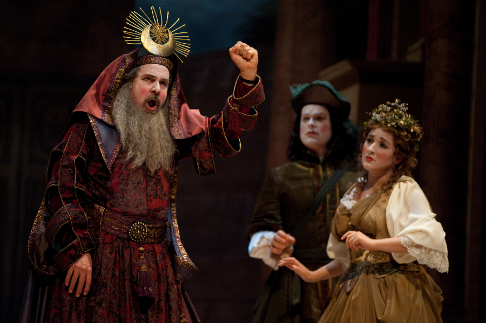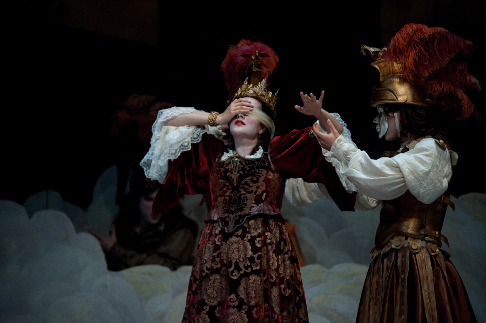20 Jun 2011
Boston Early Music Festival: Niobe, Regina di Tebe
The Boston Early Music Festival (hereinafter BEMF) has grown up.

The Boston Early Music Festival (hereinafter BEMF) has grown up.
From a specialty occasion, a meeting of minds and interests and instruments for a week every two years, its classes and performances culminating in the sometimes casual staging of a forgotten opera from an obscure corner of the repertory, cast with singers soon to become Early Music A-listers (Suzie LeBlanc, Karina Gauvin), it has become a major event on the international calendar, the most important Early Music festival in North America, a riot of concerts and classes and displays with a healthy fringe to boot. The operas are now elegant spectacles starring singers already on the international A-list (Philippe Jaroussky). This year, the opera given five performances at the colorfully restored Cutler Majestic Theater in Boston plus two more in Great Barrington is Agostino Steffani’s Niobe, Regina di Tebe, a work premiered in Munich in 1688. As the rare performances of Steffani’s operas always do, Niobe left audiences wondering how they had missed so accomplished and appealing a composer, and eager for further acquaintance with his oeuvre.
Steffani (1654-1728), though born in the Veneto, spent most of his composing career at German princely courts. He specialized in vocal music—though ballets are important in his operas, he usually subcontracted their composition. He was also a diplomat and possibly a secret agent of the Vatican during a tricky time in Central European politics. After retiring from his secular careers, he became a bishop and a high papal official, but holy orders had no effect on the worldliness of his opera plots. Famous in his day for operas, church music and for chamber compositions for vocal amateurs, his music was soon forgotten, a fate that also befell the operas of such even more famous contemporaries as Handel (a sometime protégé) and Alessandro Scarlatti. Today, a dozen masters (and many minors) of these eras are just what the opera audience craves: Operas of Cavalli, Lully, Conradi, Caldara, Vivaldi and Hasse are revived everywhere. Steffani belongs on that list; thus BEMF has gotten around to him.
BEMF’s Niobe is billed as the "North American stage premiere" of the opera (or, possibly, any Steffani opera), for those who recall the concert performance of Niobe at Alice Tully Hall in 1977 by the Clarion Society. Clarion also presented Steffani's Tassilone, and what I remember from those concerts is how impressed I was with the melodious scores, how we were all knocked over by their quality, how certain that these performances would lead to a Steffani revival. They did not. Cavalli and Handel and Rameau and Charpentier intruded, and today they can be heard in every musical capital and festival. Perhaps it is Steffani’s turn at last—the BEMF Niobe follows acclaimed recent productions at Schwetzingen, Luxembourg and Covent Garden,. One hopes that BEMF, as it has done prize-winningly in the past, will record this superb performance.
 Charles Robert Stephens, Colin Balzer, and Yulia Van Doren
Charles Robert Stephens, Colin Balzer, and Yulia Van Doren
A DVD would be an even happier idea, considering the production’s color and grandeur, but is probably beyond the resources of the festival. BEMF has given Niobe the splendor and special effects worthy of a proud ducal court under the influence of Louis XIV’s Paris: On the small but deep stage of the Cutler Majestic, we behold the glittering marble metropolis of ancient Thebes; the perilous Claude Lorrain-ish woods that surround it, which are haunted by fierce (dancing) bears, chariots drawn by winged dragons, coy shepherdesses and other wild life; a sacred fane of the goddess Latona; a magical paradise to which Mars (actually the disguised Creonte) transports the bewitched Niobe for purposes of—oh, let's keep it clean. (He succeeds, but during an intermission.) Much influenced by the operas of Lully, Steffani included many ballets in his works, and these were choreographed stylishly and in the proper period. The special effects that have always been essential to grand opera include Anfione singing to raise, magically, the walls and gates of endangered Thebes. This was surprisingly and elegantly brought off, accompanying Jaroussky’s exquisite invocation, and so made perfect dramatic and musical sense. The designers of the Met’s Ring should observe this scene to learn how mythic events can be staged without forfeiting musical and emotional power. (Gilbert Blin was the director and scenery designer. He often made do with painted flats—old technology you might say—but the painting was sumptuous, and flats made earthquakes easier to dramatize.)
In Greek mythology, Niobe was the lady who boasted of her scads of children and was duly punished by losing them and turning to stone, a myth that (I’ve always supposed) referred to the loss of innumerable youths to every passing germ in the pre-Pasteur era. Her husband, Amphion, was regarded as second only to Orpheus as a singer and player of the lyre, famed for raising the walls of Thebes by song (euhemerized as playing lively work songs to encourage the builders). That is, besides begetting Niobe’s twelve (or fourteen or however many) children, his major mythological accomplishment. In Steffani’s version, Niobe has a wandering eye most unsuitable to a matron, and Anfione, besides raising the walls with his singing, is of a philosophical turn of mind, inclined to retire from power to his deep meditations. This leads to a wonderful aria about the music of the spheres, illustrated in Boston by having his seven children circle him bearing globes of differing sizes. Jaroussky, tall, slim, handsome and bewigged like Louis XIV, sang all this movingly in his pure countertenor, none the less exciting for his prevailing calm. His style of ornament hewed scrupulously to the earlier, French style rather than the rapid divisions he performs in Handel’s operas, lingering to express “tormenti,” weeping his “pianti,” and at last (having stabbed himself) dying on a delicious fading melisma.
Amanda Forsythe, a Boston local favorite, sang Niobe. She has a dignified mien and a lovely soprano, great sensitivity to text and its tasteful ornamentation: She drew out the agonies of her “pena” (pain) in a most affecting way, and she turned convincingly to stone in the final moments of the opera. Most of the role presents her as a haughty, not to say shrewish, queen, wife and mother or a sarcastic lover, but Forsythe’s finest moment was her sensual aria of awakening in (she imagines) the arms of a god at the opening of Act III, when her lyrical runs expressed happily sated eroticism. A little later, though, humiliated at her deception, she sang an aria threatening the very gods—who punished her in due course. This revealed Forsythe’s greatest defect: Her instrument is too small for heroic outcries. Wisely, she does not force it past its natural limits, but one misses a dimension in her arias of rage. Happily, she has found her niche in Early Music, which will not often demand that she fill large halls with stormy sound; she sang Manto successfully in the London Niobe. In Boston, this secondary soprano role, a priestess in the throes of first love, hence not forced to quite such hysterical extremes of emotion as is the mobled queen, was taken by Yulia Van Doren, who won my heart with her silvery, bell-like tones, whether delighting or sorrowing or sighing. I hope to hear more of her.
 Amanda Forsythe and cast
Amanda Forsythe and cast
Colin Balzer sang Manto’s lover, Tiburino, with a most agreeable and flexible tenor. Charles Robert Stephens sang her father, the legendary know-it-all Tiresia, with pleasing resonance but little oracular command. Countertenor Matthew White made a serenely delicious Creonte. Jesse Blumberg sang wicked Poliferno with a likeable light bass but inaudible low notes. José Lemos, a contralto countertenor dressed like a baroque Katisha with stalks in his hair-do and a lewdly fluttering fan, had the stock role of the wicked old nurse played in drag, who utters cynical morals to undercut everyone else’s high-flown sentiments. His voice can be beautiful, but Nerea mostly calls for comic commentary, which he generally indicated with gravelly low notes or squawky high ones.
An array of baroque strings and winds (including recorders) spread out below the stage to the right-hand corner, where BEMF’s directors, Paul O’Dette on baroque guitar and Stephen Stubbs on some sort of keyboard, directed things, with harp, theorbo and viola da gamba joining them as continuo for the recits. This was all very pleasing except when valveless trumpets and trombones scattered about the auditorium joined the overture: Either they were playing raggedly or Steffani’s harmonies were mighty advanced. The bits of the London Niobe available on youtube suggest more effective timpani and a more modern symphonic sound there, which may have been necessary to present the work to a grand opera audience, but for Early Music fans and a smaller theater, the BEMF forces were sufficient and elegant.
Besides Gilbert Blin’s magnificent sets and Anna Watkins’ plushy costumes and the stiff but versatile PALS Children’s Chorus, who supplied and presumably trained Niobe’s enormous brood of doomed children, major credit for the evening’s splendor must be accorded to choreographers Caroline Copeland and Carlos Fittante, who designed pastorals, hunts, revels and flirtations to make the point that, at the French-influenced Munich court of Elector Max Emmanuel, dance interludes between stretches of singing were an important part of an evening’s musical entertainment.
John Yohalem